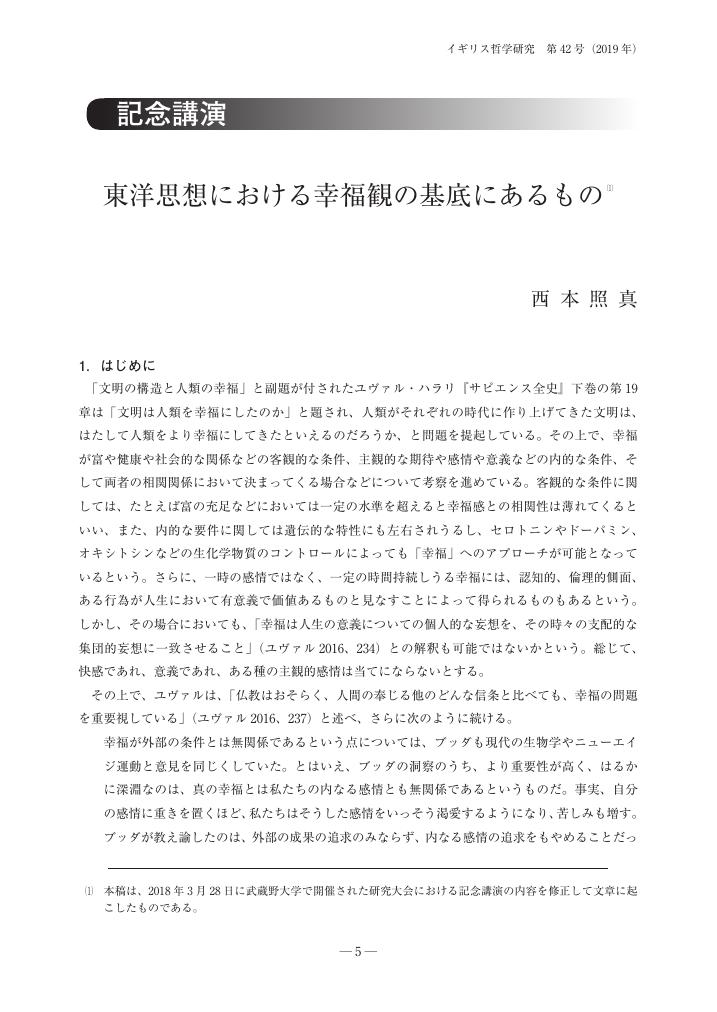2 0 0 0 OA 杏雨書屋所蔵三階教写本『普親観盲頓除十悪法』の基礎的研究
- 著者
- 西本 照真
- 出版者
- 日本印度学仏教学会
- 雑誌
- 印度學佛教學研究 (ISSN:18840051)
- 巻号頁・発行日
- vol.63, no.1, pp.1-10, 2014-12-20
2 0 0 0 OA 三階教の教団規律について : 『制法』一巻の研究
- 著者
- 西本 照真
- 出版者
- 東京大学大学院人文社会系研究科・文学部インド哲学仏教学研究室
- 雑誌
- インド哲学仏教学研究 (ISSN:09197907)
- 巻号頁・発行日
- vol.3, pp.61-75, 1995-10-31
There are some Tun-huang manuscripts of the San-chieh-chiao (三階教) that have not been introduced by Keiki Yabuki and others. One of them is Pelliot 2849 (P2849), which I presume was transcribed in the 7th or 8th century. There are three texts in it. One of them is titled the Chih-fa (制法 Enacted Regulations, hereafter CF) and consists of twenty provisions with a prologue, the first five prescribing general remarks and the remaining fifteen enumerating particular cases. This paper starts with the hypothesis that the CF presents regulations for the San-chieh-chiao monastic life, and proves it through the analysis of mainly the first five provisions in comparison with other San-chieh-chiao texts. The results are as follows: 1. The model type of monk that the CF describes is called the "dumb sheep monk'(CF 1&2). "Dumb sheep" is a metaphor for monks who are very slow in reacting in religious matters and remain. silent. In the terminal age (末世) no judgments can be correct; therefore it is best for monks not to judge at all. If one is a "dumb sheep monk" then there is no fear of one's distinguishing between good and evil. The "dumb sheep monk" is also listed as a model for fellow trainee in the Tui-ken ch'i-hsing fa (対根起行法, TK). 2. While the San-chieh-chiao texts, as a whole, make great account of the teaching of the "four standards" (Catvāri pratisaraņāni), the CF 3 emphasizes that the trainee should depend on the sūtra, not on persons, since there are many perverse people and very few righteous in the terminal age. This attitude is reflected in the fact that a rigid distinction is made between the sūtra's words and the text writer's words. 3. The phases of the stage that the CF shows are those of "bad world," "bad time," and "bad people" (CF 4). Under the situation called "the Third Stage" in the San-chieh-chiao teaching, the ways of practicing to enter the realm of enlightenment are to reflect on one's own evil, to venerate others'goodness, to concentrate on just one practice, to train oneself for one's own benefit, and so forth. 4. The sentences about fellow trainees in the CF 5 almost agree with those in the manuscripts of the San-chieh fo-fa (三階仏法, SC, written in 592) 4 in Japan. The style is imperative and fits with regulations, which is essential to the content of the CF but somewhat alien to the SC. It is presumable that the CF was enacted before 592, and the SC quoted the sentences from the CF. These studies verify the hypothesis mentioned above, that the CF gives regulations for the San-chieh-chiao monastic life. According to Hsin-hsing's biography in the Hsü kao-seng chuan (続高僧伝), he wrote a work named the Shang-tung so-chip chung-shih chu-fa (山東所制衆事諸法 ST) before moving to Ch'ang-an in 589. This is also presumed to contain regulations for the San-chieh-chiao, and it might be the CF itself. Even if the CF is different from the ST, it must have been written not long after he moved to Ch'ang-an. The latest date of the CF's enactment was presumably not long after 589. On the other hand, in some of the catalogues, such as the K'ai-yüan-shih-chiao-lu (開元釈教録), one of the San-chieh-chiao texts named the Ta-chung chih-fa (大衆制法) is listed. This text can probably be identified with the CF.
1 0 0 0 ブッダ・ダルマ作品集
- 著者
- 石上智康 西本照真 松本紹圭著
- 出版者
- 武蔵野大学
- 巻号頁・発行日
- 2023
1 0 0 0 OA 東洋思想における幸福観の基底にあるもの
- 著者
- 西本 照真
- 出版者
- 日本イギリス哲学会
- 雑誌
- イギリス哲学研究 (ISSN:03877450)
- 巻号頁・発行日
- vol.42, pp.5-13, 2019-03-20 (Released:2020-04-28)
- 参考文献数
- 6
- 著者
- 西本 照真
- 出版者
- 東アジア仏教研究会
- 雑誌
- 東アジア仏教研究 (ISSN:13484532)
- 巻号頁・発行日
- no.10, pp.37-55, 2012-05
1 0 0 0 OA 三階教写本『人集録明諸経中対根浅深発菩提心法』
- 著者
- 西本 照真
- 出版者
- 日本印度学仏教学会
- 雑誌
- 印度學佛教學研究 (ISSN:00194344)
- 巻号頁・発行日
- vol.61, no.2, pp.1003-997, 2013-03-20 (Released:2017-09-01)
1 0 0 0 OA 杏雨書屋所蔵三階教写本『普親観盲頓除十悪法』の基礎的研究
- 著者
- 西本 照真
- 出版者
- 日本印度学仏教学会
- 雑誌
- 印度學佛教學研究 (ISSN:00194344)
- 巻号頁・発行日
- vol.63, no.1, pp.1-10, 2014-12-20 (Released:2017-09-01)
1 0 0 0 OA 『無量寿観経纉述』の新出写本について -北京新1202とP3014を中心として-
- 著者
- 西本 照真
- 出版者
- Japanese Association of Indian and Buddhist Studies
- 雑誌
- 印度學佛教學研究 (ISSN:00194344)
- 巻号頁・発行日
- vol.53, no.2, pp.792-787, 2005-03-20 (Released:2010-03-09)
1 0 0 0 OA 三階教写本研究の現況-新資料の紹介を中心として-
- 著者
- 西本 照真
- 出版者
- Japanese Association of Indian and Buddhist Studies
- 雑誌
- 印度學佛教學研究 (ISSN:00194344)
- 巻号頁・発行日
- vol.52, no.1, pp.16-21, 2003-12-20 (Released:2010-03-09)
1 0 0 0 七世紀以降の三階教思想の展開について
平成11年度の研究実績の概要は以下のとおりである。1.歴史学的研究『隋唐五代墓誌〓編』(全30巻)中の墓石資料を調査した結果、澄心寺比丘尼優曇禅師が三階教僧であったことが明らかになった。なお、平成12年3月の西安一帯の墓碑調査の結果、同禅師の墓碑銘は昭陵博物館に保存されていることが確認された。2.文献学的研究(1)敦煌遺書北新1002号(『仏性観修繕法』)は首尾を欠いた写本であるが、筆者が三階教文献として注目していた北京8386が文献の後半部分を筆写した写本であることを特定した。このことにより『仏性観修繕法』の全文がよみがえったことになる。(2)敦煌本と本邦本と『三階仏法』の成立と伝播について、七寺写本の特徴も含めて明らかにした。3.思想史的研究昨年度から研究を続けていた『三階観法略釈』(P2268)の思想内容の分析を終え、同文献には華厳や禅の思想的の影響が見られること、成立は7世紀半ば以降であることなどを明らかにした。





